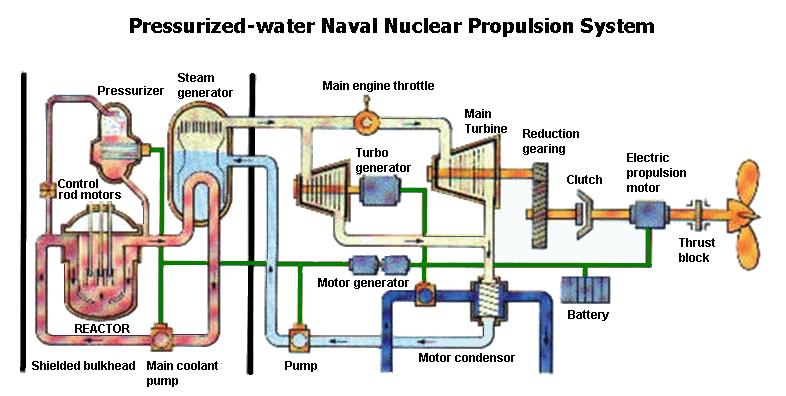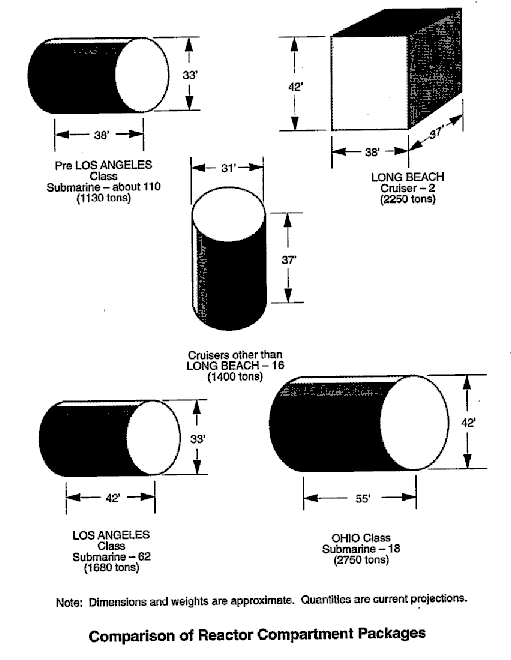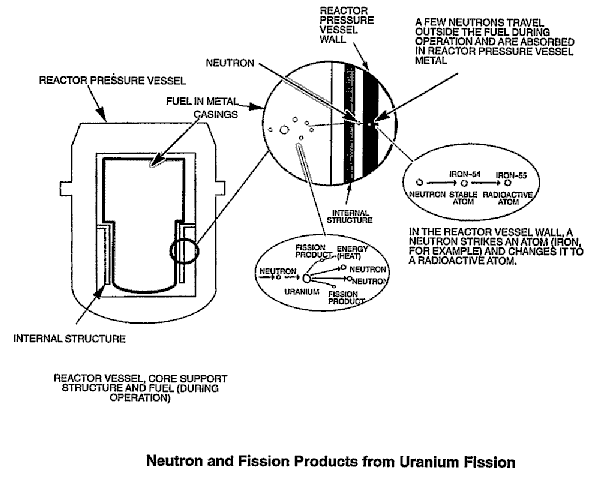 |  |  |  |
 |  |  | |
 |  |  |



A nuclear-powered ship is constructed with the nuclear power plant inside a section of the ship cded the reactor compartment. The components of the nuclear power plant include a high-strength steel reactor vessel, heat exchanger(s) (steam generator), and associated piping, pumps, and valves. Each reactor plant contains over 100 tons of lead shielding, part of which is made radioactive by contact with radioactive material or by neutron activation of impurities in the lead.
The propulsion plant of a nuclear-powered ship or submarine uses a nuclear reactor to generate heat. The heat comes from the fissioning of nuclear fuel contained within the reactor. Since the fisioning process also produces radiation, shields are placed around the reactor so that the crew is protected.
The nuclear propulsion plant uses a pressurized water reactor design which has two basic systems - a primary system and a secondary system. The primary system circulates ordinary water and consists of the reactor, piping loops, pumps and steam generators. The heat produced in the reactor is transferred to the water under high pressure so it does not boil. This water is pumped through the steam generators and back into the reactor for re-heating.
In the steam generators, the heat from the water in the primary system is transferred to the secondary system to create steam. The secondary system is isolated from the primary system so that the water in the two systems does not intermix.
In the secondary system, the steam flows from the steam generators to drive the turbine generators, which supply the ship with electricity, and to the main propulsion turbines, which drive the propeller. After passing through the turbines, the steam is condensed into water which is fed back to the steam generators by the feed pumps. Thus, both the primary and secondary systems are closed systems where water is recirculated and renewed.
Since there is no step in the generation of this power which requires the presence of air or oxygen, this allows the ship to operate completely independent from the earth’s atmosphere for extended periods of time.
 |  |  |  |
 |  |  | |
 |  |  |
Naval reactors undergo repeated power changes for ship maneuvering, unlike civilian counterparts which operate at steady state. Nuclear safety, radiation, shock, quieting, and operating performance requirements in addition to operation in close proximity to the crew dictate exceptionally high standards for component manufacturing and quality assurance. The internals of a Naval reactor remain inaccessible for inspection or replacement throughout a long core life -- unlike a typical commercial nuclear reactor, which is opened for refueling roughly every eighteen months.

The Naval Reactors' program has shown the world that nuclear power can be handled safely, with no adverse effects on the public or the environment. While others have stumbled with this challenging technology, the Naval Reactors' program stands out-in the private sector as well as in the public sector-for vision, discipline, and technical excellence.
The nuclear propulsion plants in United States Navy ships, while differing in size and component arrangements, are all rugged, compact, pressurized water reactors designed, constructed, and operated to exacting criteria. The nuclear components of these plants are all housed in a section of the ship called the reactor compartment. The reactor compartments all serve the same purpose but may have different shapes depending on the type of ship. For submarines, the reactor compartment is a horizontal cyhder formed by a section of the ship�s pressure hull, with shielded bulkheads on each end. Cruiser reactor compartments are shielded vertical cylinders or shielded rectangular boxes deep within the ship�s structure.


Radioactivity is created during fission because some of these fission products are highly radioactive when they are formed. Most of the radioactivity produced by nuclear fuel is in the fission products. The uranium fuel in naval nuclear proptision reactor cores uses highly corrosion-resistant and highly radiation-resistant fuel and cladtig. As a resdt, the fuel is very strong and has very high integrity. The fuel is designed, built, and tested to ensure that the fuel construction will contain and hold the radioactive fission products. Naval fuel totally contains fission products with the fuel - there is no fission product release from the fuel in normal operation.
Fissioning of uranium also produces neutrons while the nuclear power plant is operating. Most of the neutrons produced are absorbed by the atoms within the fuel and continue the chain reaction. However, some of the neutrons travel away from the fuel, go outside the fuel, and are absorbed in the metal structure which supports the fuel or in the walls of the reactor pressure vessel. Trace amounts of corrosion and wear products are carried by reactor coolant from reactor plant metal surfaces. Some of these become radioactive born exposure to neutrons.Reactor coolant carries some of these radioactive products through the piping systems where a portion of the radioactivity is removed by a purification system. Most of the remaining radionuclides transported from the reactor core deposit in the piping systems. These neutrons, when absorbed in the nucleus of a nonradioactive atom like iron, can produce a radioactive atom. For example, iron-54 contains a total of 54 particles. Adding an additiond neutron produces an atom containing 55 particles, called iron-55. This atom is radioactive. At some later time, it changes into a nonradioactive manganese-55 atom by releasing energy in the form of radiation. This is called radioactive decay.
Due to the need for sallors to live on the ships during operation, reactor compartments are designed to attenuate radiation levels outside of the reactor compartment to extremely low levels. The external surface radiation levels for the normal conditions of transportation of the cruisers and LOS ANGELES Class and 0HI0 Class submarines are expected to be a fraction of the 200 mrem per hour on contact tit dewed under 49CFR173.To test and operate his reactor plant, Rickover put together an organization which has thrived to this day. Westinghouse's Bettis Atomic Power Laboratory was assigned responsibility for operating the reactor it had designed and built. The crew was increasingly augmented by naval personnel as the cadre of trained operators grew. Admiral Rickover ensured safe operation of the reactor plant through the enforcement of the strictest standards of technical and procedural compliance.
At the site and at the STR, two missions for the prototype quickly emerged. First was the research and development of advanced reactor plant designs and procedures for the fleet. Second was the mission of training and certifying operators for the fleet. And the fleet came quickly and in large numbers. STR was redesigned S1W, the prototype of the USS NAUTILUS and was followed in the middle to late '50s by A1W, the prototype of the aircraft carrier, USS ENTERPRISE. Also in the late '50s, the Expended Core Facility was built. It is used to this day to examine expended naval reactor fuel to aid in the improvement of future generations of naval reactors. Finally, in the middle 1960s, S5G, the prototype of the submarine, USS NARWHAL, and predecessor to the reactor plant used to propel the Trident Fleet Ballistic Missile Submarines, was built and place in service.As the Navy's presence expanded in eastern Idaho, slowly but surely the Navy support organization matured. By late 1954, the Nuclear Power Training Unit was established. In 1961, the Naval Administrative Unit set up shop in Blackfoot. In 1965, the unit moved to its present location in Idaho Falls, and over the next 30 years, continued to expand and improve its services. By 1979, a separate Personnel Support Detachment had arrived. 1982 saw a branch dental clinic established, and 1983 ushered in a branch medical clinic.
In the early 1950s work was initiated at the Idaho National Engineering and Environmental Laboratory to develop reactor prototypes for the US Navy. The Naval Reactors Facility, a part of the Bettis Atomic Power Laboratory, was established to support development of naval nuclear propulsion. The facility is operated by Westinghouse Electric Corporation under the direct supervision of the DOE's Office of Naval Reactors. The facility supports the Naval Nuclear Propulsion Program by carrying out assigned testing, examination, and spent fuel management activities.
The facility consists of three naval nuclear reactor prototype plants, the Expended Core Facility, and various support buildings. The submarine thermal reactor prototype was constructed in 1951 and shut down in 1989; the large ship reactor prototype was constructed in 1958 and shut down in 1994; and the submarine reactor plant prototype was constructed in 1965 and shut down in 1995. The prototypes were used to train sailors for the nuclear navy and for research and development purposes. The Expended Core Facility, which receives, inspects, and conducts research on naval nuclear fuel, was constructed in 1958 and is still operational.
The initial power run of the prototype reactor (S1W) for the first nuclear submarine, the Nautilus, was conducted at the INEEL in 1953. The A1W prototype facility consists of a dual-pressurized water reactor plant within a portion of the steel hull designed to replicate the aircraft carrier Enterprise. This facility began operations in 1958 and was the first designed to have two reactors providing power to the propeller shaft of one ship. The S5G reactor is a prototype pressurized water reactor that operates in either a forced or natural circulation flow mode. Coolant flow through the reactor is caused by thermal circulation rather than pumps. The S5G prototype plant was installed in an actual submarine hull section capable of simulating the rolling motions of a ship at sea. The unique contributions of these three reactor prototypes to the development of the United States Nuclear Navy make them potentially eligible for nomination to the National Register of Historic Places.
The Test Reactor Area (TRA) occupies 102 acres in the southwest portion of the INEL. The TRA was established in the early 1950s with the development of the Materials Test Reactor. Two other major reactors were subsequently built at the TRA: the Engineering Test Reactor and the Advanced Test Reactor. The Engineering Test Reactor has been inactive since January 1982. The Materials Test Reactor was shut down in 1970, and the building is now used for offices, storage, and experimental test areas. The major program at the TRA is now the Advanced Test Reactor. Since the Advanced Test Reactor achieved criticality in 1967, it's been used almost exclusively by the Department of Energy's Naval Reactors Program. After almost 30 years of operation, this reactor is still considered a premier test facility. And it's projected to remain a major facility for research, radiation testing, and isotope production into the next century.The Navy makes shipments of naval spent fuel to INEL that are necessary to meet national security requirements to defuel or refuel nuclear powered submarines, surface warships, or naval prototype or training reactors, or to ensure examination of naval spent fuel from these sources. The Secretary of Defense, upon notice to the Governor of the State of Idaho, certifies the total number of such shipments of naval spent fuel required to be made through the year 2035. The Navy will not ship more than twenty four (24) shipments to INEL from the date of this Agreement through the end of 1995, no more than thirty six (36) shipments in 1996, and no more than twenty (20) shipments per year in calendar years 1997 through 2000. From calendar year 2001 through 2035, the Navy may ship a running average of no more than twenty (20) shipments per year to INEL. The total number of shipments of naval spent fuel to INEL through 2035 shall not exceed 575. Shipments of naval spent fuel to INEL through 2035 shall not exceed 55 metric tons of spent fuel.
An estimated cost for land burial of the reactor compartments is $10.2 million for each LOS ANGELES Class submarine reactor compartment, $12.8 million for each 0HIO Class submarine reactor compartment, and $40 million for each cruiser reactor compartment. The estimated total Shipyard occupational exposure to prepare the reactor compartment disposd packages is 13 rem (approximately 0.005 additiond latent cancer fatalities) for each LOS ANGELES Class submarine package, 14 rem (approximately 0.006 addtiond latent cancer fatalities) for each 0~0 Class submarine package and 25 rem (approximately 0.01 additiond latent cancer fatalities) for each cruiser package.